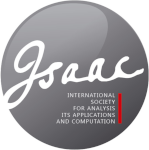Plenary lectures
Maarten de Hoop (Rice University, USA)
We present advances in the analysis of inverse problems associated with the theory of wave propagation and scattering in models of anisotropic elasticity, which are expected to describe material properties in crust and mantle of terrestrial planets. Propagation of singularities lead to geometric inverse problems; we will discuss how techniques from microlocal analysis and Finsler geometry come into play. We include the case of data generated by unknown interior sources. We will summarize consequences of elastic anisotropy through the lens of algebraic geometry. Finally, we will show results pertaining to time-harmonic and dynamic inverse boundary value problems associated with elastic waves, exploiting unique continuation, relevant in exploration seismics.Guido De Philippis (Courant Institute of Mathematical Sciences New York, USA)
Plateau problem consists in finding a surface of minimal area among the ones spanning a given curve. It is among the oldest problem in the calculus of variations and its study lead to wonderful development in mathematics.Federer and Fleming integral currents provide a suitably weak solution to the Plateau problem in arbitrary Riemannian manifolds, in any dimension and co-dimension. Once this weak solution has been found a natural question consists in understanding whether it is classical one, i.e. a smooth minimal surface. This is the topic of the regularity theory, which naturally splits into interior regularity and boundary regularity. After the monumental work of Almgren, revised by De Lellis and Spadaro, interior regularity is by now well understood. Boundary regularity is instead less clear and some new phenomena appear.
Aim of the talk is to give an overview of the problem and to present some boundary regularity results we have obtained in the last years.
This is based on joint works with C. De Lellis, J. Hirsch and A. Massaccesi.
Stéphane Jaffard (Université Paris-Est Créteil, France)
Multifractal analysis quantifies the fluctuations of regularities in functions through the estimation of their ”multifractal spectrum” which encapsulates the fractional dimensions of the singularity sets of a function. Wavelet techniques supply robust tools in order to perform multifractal analysis, and they became a standard signal/image processing method for classification or model selection, successfully used in a large variety of applications. Yet, successes were confined to the analysis of one signal or image at a time (univariate analysis). In view of many modern real-world applications that rely on the joint (multivariate) analysis of collections of signals or images, the need for extensions to multivariate settings became a major challenge.We will describe the theoretical foundations of multivariate multifractal analysis, which pro- poses to estimate the multivariate multifractal spectrum of several signals as a new way to reveal the correlations between their singularity sets. We will study the properties and limitations of the most natural extension of the univariate formalism to a multivariate formulation, and explain why, while performing well for some models, this natural extension is not valid in general. We will illustrate these theoretical results by numerical computations worked out for several classical models of stochastic processes.
Barbara Kaltenbacher (Alpen-Adria-Universität Klagenfurt, Austria)
High intensity (focused) ultrasound HIFU is used in numerous medical and industrial applications ranging from litotripsy and thermotherapy via ultrasound cleaning and welding to sonochemistry. We will highlight certain mathematical and computational aspects related to the relevant nonlinear acoustic phenomena, namely- modeling of high intensity ultrasound phenomena as second and higher order wave equations
- some parameter asymptotics
- absorbing boundary conditions for the treatment of open domain problems
- optimal shape design and boundary control problems in the context of HIFU
Arno Kuijlaars (Katholieke Universiteit Leuven, Belgium)
Eigenvalues of random matrices show a remarkable regular pattern as the size tends to infinity. This has been studied in great detail for the class of unitarily invariant ensembles of Hermitian matrices, where powerful tools from orthogonal polynomials and potential theory can be used. I will give an overview of this development and some of its extensions that include multiple orthogonal polynomials.
Kristian Seip (Norwegian University of Science and Technology, Norway)
It has been recognized by many authors that contractive inequalities involving norms of Hp spaces can be particularly useful when the objects in question (like the norms and/or an underlying operator) lift in a multiplicative way from one (or few) to several (or infinitely many) variables. This has been my main motivation for looking more systematically at various contractive inequalities in the context of Hardy spaces on the d-dimensional torus. I will discuss results from recent studies of Hardy–Littlewood inequalities, Riesz projections, idempotent Fourier multipliers, and Hilbert points (which in one variable is another word for inner functions). We will see interesting phenomena occurring both in the transition from low to high dimension and from low to infinite dimension. The talk builds on joint work with Sergei Konyagin, Hervé Queffélec, and Eero Saksman and with Ole Fredrik Brevig and Joaquim Ortega-Cerdà.
